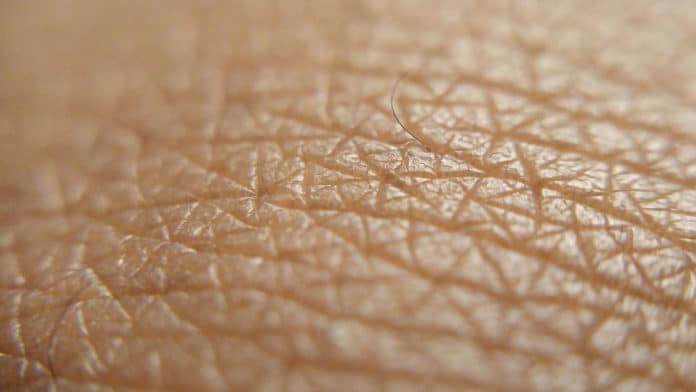Most protective biological tissues, such as mammalian skin, fish scales, crustacean shells, and nut and seed shells, are structurally comprised of a stiff and thin outer layer on an underlying soft substrate. While these composite skin-like tissues are ubiquitous, their failure mechanics and the potential mechanical advantages their composite structures offer remain unclear.
In a new study, scientists from Binghamton University, State University of New York, studied the structure of human skin and the amount of damage it can sustain. They found that human skin has evolved to allow maximum durability and flexibility.
The scientists employed polydimethylsiloxane (PDMS), an inert and non-toxic material often used in biomedical research, to produce membranes. By covering a soft, flexible layer with a thinner, stiffer outer layer, they mimicked the structure of mammalian skin.
After that, the “artificial skin” was put through tests to evaluate how much force it could withstand before breaking. The samples were indented to produce large divots before breaking under the pressure of a sharp or blunt rod. In addition, the scientists made an intriguing discovery.
Associate Professor of Biomedical Engineering Guy German said, “There’s a certain optimal structural form.”
“We found that when the artificial skin has the same outer (stratum corneum) and inner layer thickness (dermis) as mammalian skin, the rubber membranes maximized both their puncture toughness and deformability. We believe that mammalian skin has evolved or adapted itself to offer the toughest option to mechanical threats while remaining as deformable as possible.”
“Mammalian skin offers maximum locomotion and maximum mechanical toughness. If it went one way, it would be less flexible, or the other way, you would get more flexibility but less toughness. So it’s optimized.“
Scientists also discovered a new type of failure called coring. Puncturing a material will create a fracture below the indenter tip, like piercing a piece of paper with a pencil. However, fracturing occurs far from the indenter tip in hyperelastic two-layered materials like human skin and these artificial skin membranes at great indentation depths. The membrane ruptures where it is most stretched, on the sides of the divot, creating a cylindrical core in the membrane. They believe this event has never been seen before.
German said, “A better understanding of the structure of skin — and artificial skin — will help with various technologies, from flexible electronics and medical devices to product packaging, bulletproof vests, and treatments for burn victims. These potential uses (and more) mean that researching human skin and how it evolved into its current form is increasingly popular in recent years.”
“Scientists and engineers are attracted to studying skin because it’s difficult to understand. Skin is heterogeneous and structurally very complex.”
According to German, advanced computational techniques has helped the team better understand skin biomechanics.
Journal Reference:
- Christopher H. Maiorana, Rajeshwari A. Jotawar, Guy K. German. Biomechanical fracture mechanics of composite layered skin-like materials. Soft Matter, 2022; 18 (10): 2104 DOI: 10.1039/D1SM01187A
